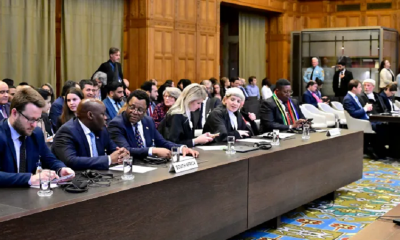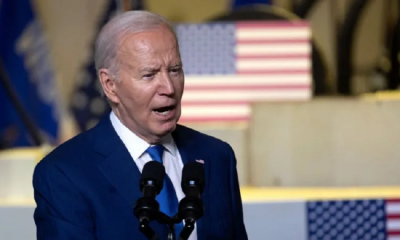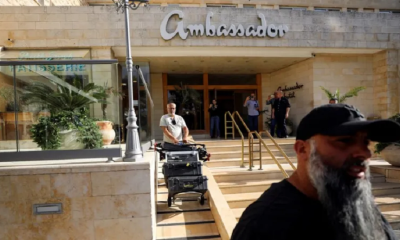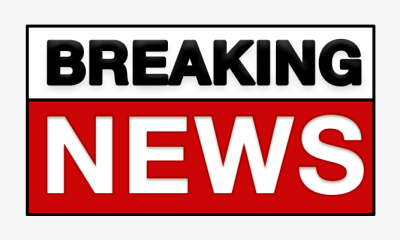Foreign News
Fears for Gazans as aid groups halt work over deadly Israeli strike
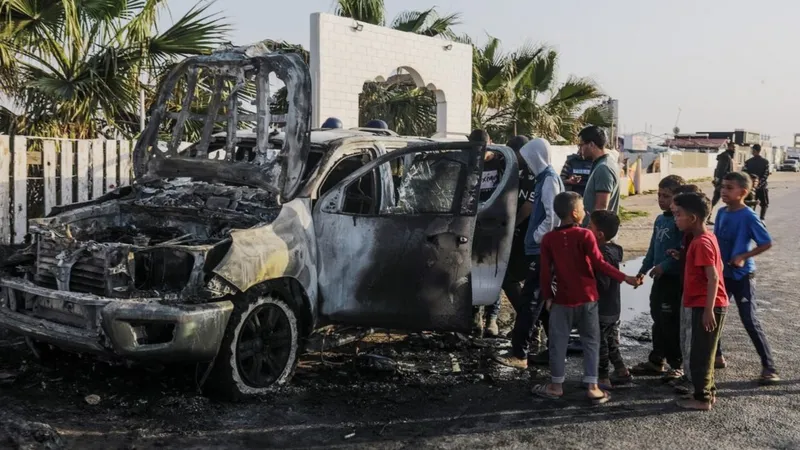
Many Palestinians in the Gaza Strip will be wondering how they are going to feed their families after World Central Kitchen (WCK) paused its operations in response to the killing of seven of its aid workers in an Israeli air strike.
Another US charity it works with, Anera, has also suspended work because of the escalating risks faced by its local staff and their families.
Together, they were serving two million meals a week across the Palestinian territory, where the UN has warned that an estimated 1.1 million people – half the population – are facing catastrophic hunger because of Israeli restrictions on aid deliveries, the ongoing hostilities and the breakdown of order.
WCK’s decision to pause its work also led to the “freezing” of a maritime aid corridor from Cyprus, which the charity helped set up last month to increase the trickle of aid getting into the north of Gaza and avert a looming famine.
The WCK convoy was hit on Monday night as it travelled south along the Israeli-designated coastal aid route, just after they had unloaded more than 100 tonnes of food from a barge at a warehouse in Deir al-Balah.
That barge was part of a four-vessel flotilla that sailed back to Cyprus with 240 tonnes of supplies that could not be brought ashore in the wake of the strike.
The Norwegian Refugee Council warned that “what happened to World Central Kitchen threatens the entire aid system” and had left it “on the brink”.
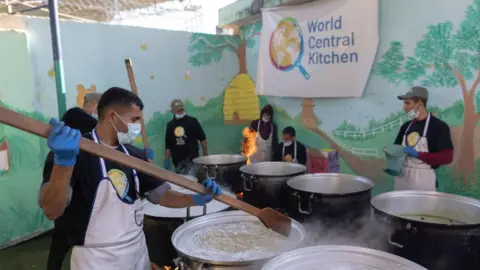
Before the strike, World Central Kitchen was providing about 350,000 meals across Gaza each day
WCK accused the Israeli military of a “targeted attack” on vehicles clearly marked with the charity’s logo and whose movements had been co-ordinated with Israel authorities. The victims were British, Polish, Australian and Palestinian, and also included a dual US-Canadian citizen.
The military’s chief of staff, Lt Gen Herzi Halevi, described the strike as a “grave mistake” that had followed “misidentification at night”.
He also vowed to take “immediate action” to ensure that more was done to protect aid workers, including the immediate establishment of a new “humanitarian command centre” to improve co-ordination. “Israel is at war with Hamas, not with the people of Gaza,” he stressed.
However, aid groups say they are not sure such promises will lead to meaningful changes. They also assert that this was not an isolated incident, with 196 Palestinian aid workers reportedly killed since the war began in October.
Jan Egeland, the secretary-general of the Norwegian Refugee Council and a former UN humanitarian chief, told the BBC that WCK was “among those who have the closest co-operation with the Israelis”, in terms of sharing information about their workers’ locations and planned movements.
Before the strike, WCK was playing an increasingly prominent and important role in Gaza, with 400 Palestinian staff and 3,000 people working indirectly in its 68 community kitchens and distribution system across the territory.
WCK provided 12% of the 193,000 tonnes of aid from international organisations that had reached Gaza as of Tuesday, according to data from Cogat, the Israeli defence ministry body tasked with co-ordinating deliveries. However, UN agencies were responsible for 80% of the total.
WCK’s founder, the chef José Andrés, told Reuters news agency on Wednesday that it was “analysing the situation and how to keep doing the work we do”.
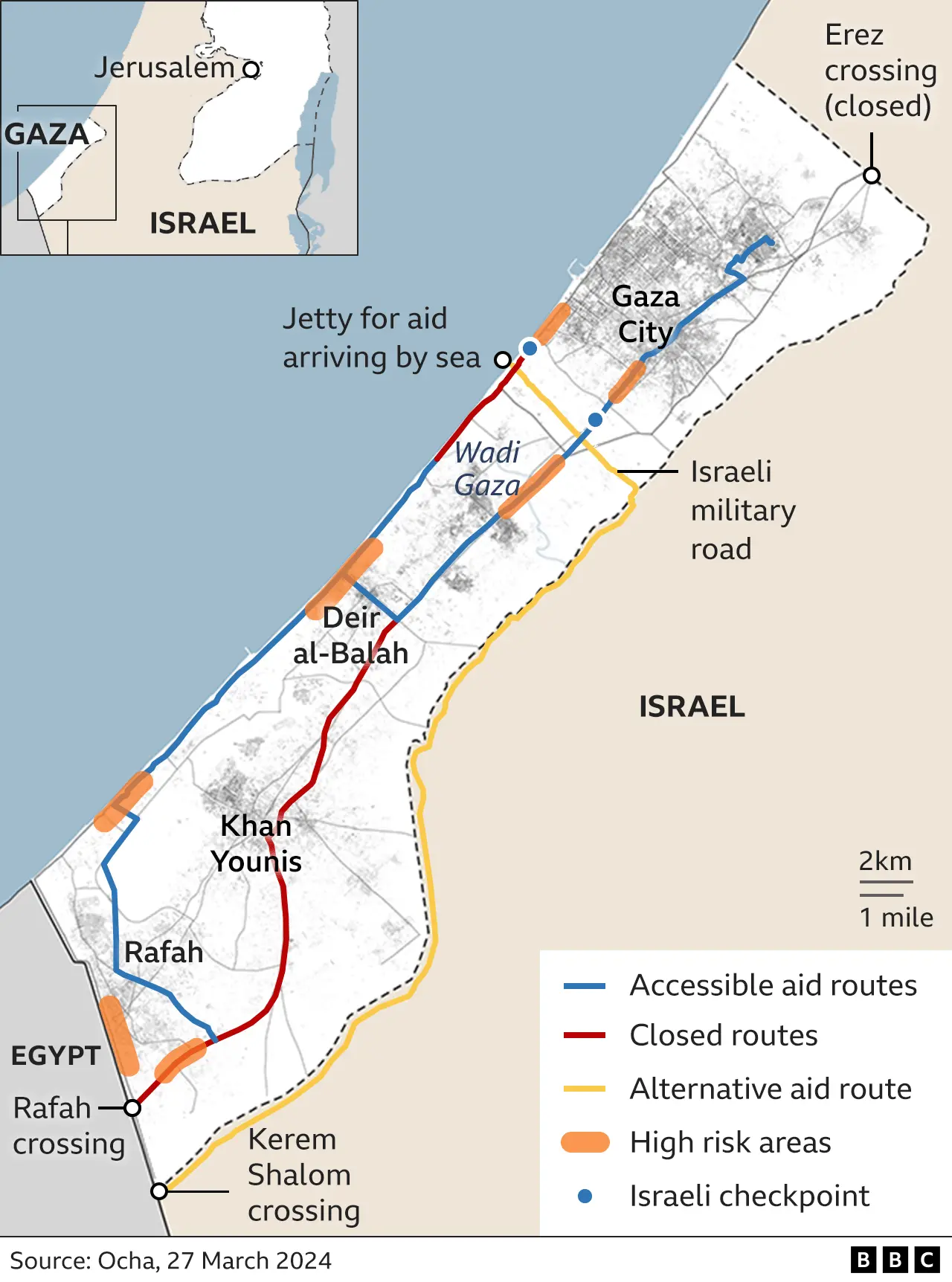
Anera – which was providing 150,000 meals a day in collaboration with WCK – said it understood the consequences pausing its own work would have on Palestinians, but that its Palestinian staff had for the first time deemed the risk to their safety and that of their families “intolerable”.
It said the charity’s logistics co-ordinator and his son had been killed in an Israeli air strike in Deir al-Balah in March, despite the fact that the co-ordinates of the shelter where they were staying had been provided to the Israeli military. “We’ve asked for explanation as to why that site was struck and we’ve received none,” Derek Madsen of Anera told the BBC. “These sites are known and so I think it is very difficult for us to understand how these strikes happen.”
For the people of Gaza, the suspension of WCK’s operations “means more famine, more dead children, more epidemic disease because people are so malnourished”, Mr Egeland warned.
At least 27 children are reported to have died as a result of malnutrition since October, according to the World Health Organization.
Mr Egeland urged Israel to start by opening the Karni and Erez border crossings with northern Gaza to allow aid convoys to drive there directly.
Most aid convoys are currently forced to start at the Israeli-controlled Kerem Shalom and Egyptian-controlled Rafah crossings with the south of Gaza and then pass through what the UN calls “high-risk areas”, mainly due to shooting and shelling or the breakdown in civil order.
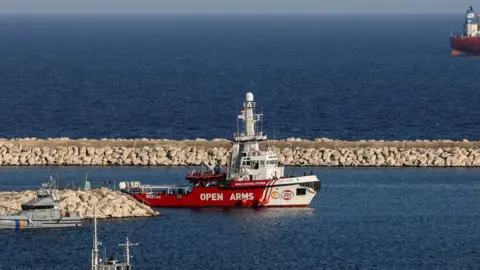
The Open Arms. a Spanish charity vessel, returned to Cyprus on Wednesday after the maritime aid route was suspended (BBC)
Cogat says Israeli forces have co-ordinated the entry of more than 500 lorries into the north over the past two months via those routes as well as a new gate and military road that runs south of Gaza City.
Israel has also facilitated the now-suspended maritime corridor set up by WCK as well as airdrops of aid by Western and Arab countries, which the UN says are both helpful but cannot replace the large-scale delivery of aid by land.
The first WCK aid ship was carrying 200 tonnes of aid and took several days to reach Gaza. By comparison, a lorry can carry about 20 tonnes and the nearest Israeli container port is only a 40km drive from northern Gaza.
A C-130 transport plane meanwhile has a maximum payload of 21 tonnes, but only about 40 airdrops have taken place so far and they are considered expensive, ineffective and dangerous for people on the ground.
The UN says 159 lorry loads of aid crossed into Gaza by land each day on average between 1 and 28 March, and that the pre-war average was 500 lorry loads, including fuel.
Cogat says the pre-war average only included 70 food lorries and that 140 entered each day during March. It insists there is no limit to the amount of food and other humanitarian aid that can enter Gaza and accuses UN agencies of failing to distribute aid effectively.
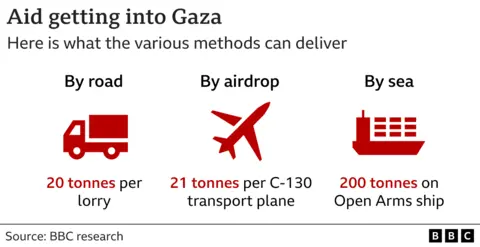
There was no apparent drop-off in aid crossing into Gaza following the strike on the WCK convoy, with 217 lorries transferred via Israel and Egypt on Wednesday and 179 food packages being airdropped, according to Cogat.
But Nate Mook, who was chief executive of WCK until 2022, warned that the longer-term consequences could be “devastating” for Gazans because “we probably have not seen the last of the aid organisations to pull out”.
Aseel Baidoun of Medical Aid for Palestinians said it had not suspended operations after a strike in January damaged a residential compound that housed the British charity’s local team and their families, injuring several people. But now, she added: “We really are scared of the security situation.”
Natalia Anguera of Action Against Hunger told the BBC that it would try to continue working despite “more and more challenging” conditions.
“Most of our staff are… Palestinians. They are suffering themselves, but they also have a very strong and clear commitment to their humanitarian mandate. They want to go on delivering,” she said.
She said the international community needed to push strongly for a humanitarian ceasefire because it was the only way that aid organisations would be able to scale up their response to the level required.
Mr Egeland also stressed the importance of the UN agency for Palestinian refugees (UNRWA), which he said was “bigger than the rest of us combined” but was being “systematically undermined by Israel”.
Israel accuses UNRWA of supporting Hamas, which triggered the war when its gunmen attacked southern Israel on 7 October last year. The agency has denied this, but in January it sacked nine of the 12 employees accused in an Israeli document of playing a part in the attacks.
UNRWA called for a “complete reversal in policies” from Israel in response to Monday’s strike, including lifting the ban on it delivering aid to northern Gaza.
(BBC)
Foreign News
Child damages €50m Rothko painting in Dutch museum

A child has damaged a painting worth millions of pounds by the American artist Mark Rothko at a museum in Rotterdam.
A spokesperson for the Museum Boijmans Van Beuningen said it was considering the “next steps” for the treatment of Rothko’s Grey, Orange on Maroon, No. 8.
The damage occurred during an “unguarded moment”, a museum spokesperson told the Dutch media outlet Algemeen Dagblad (AD) last week.
A spokesperson for the museum told the BBC the damage was “superficial”, adding: “Small scratches are visible in the unvarnished paint layer in the lower part of the painting”.
The abstract painting is estimated to be worth up to €50m (£42.5m), according to newspaper AD.
“Conservation expertise has been sought in the Netherlands and abroad. We are currently researching the next steps for the treatment of the painting”, the museum spokesperson told the BBC.
“We expect that the work will be able to be shown again in the future,” they added.
Sophie McAloone, the conservation manager at the Fine Art Restoration Company, said that “modern unvarnished” paintings like Rothko’s Grey, Orange on Maroon, No. 8 are “particularly susceptible to damage”.
This is “owing to a combination of their complex modern materials, lack of a traditional coating layer, and intensity of flat colour fields, which make even the smallest areas of damage instantly perceptible,” she said.
“In this case, scratching of the upper paint layers can have a significant impact on the viewing experience of the piece,” Ms McAloone said.
The Rothko painting was hanging in the museum’s Depot – a publicly accessible storage facility beside the main museum – as part of an exhibition displaying a selection of “public favourites” from the gallery’s collection.
Jonny Helm, a marketing manager at the art restoration service Plowden & Smith, said the incident had implications for UK institutions such as V&A East and the British Museum, which are considering “opening up the display of things that would otherwise be obscured in archives.”
“How will this event affect other UK institutions who are opening up their archives in the same way?” Mr Helm said.
Restoring a Rothko painting is a difficult task because “Rothko’s mixture of pigments and resins and glues were quite complex”, Mr Helm said.
He said the fact the painting is unvarnished – meaning it is “open to the environment” – will pose an additional challenge to conservators.
Conservators working to restore the painting will now likely be in the process of documenting the extent of the damage and researching “historic successful treatments” of Rothko paintings.
“Rothko works seem to have terrible luck – this isn’t the first damaged Rothko we’ve heard about,” Mr Helm said.
Rothko’s 1958 work, Black on Maroon, was deliberately vandalised by Wlodzimier Umanjec at London’s Tate Modern gallery in October 2012. Umaniec was sent to prison for two years and subsequently apologised for his actions.
During his trial, prosecuting barrister Gregor McKinley said the cost of repairing the work would be about £200,000. It took conservators 18 months to repair the painting.
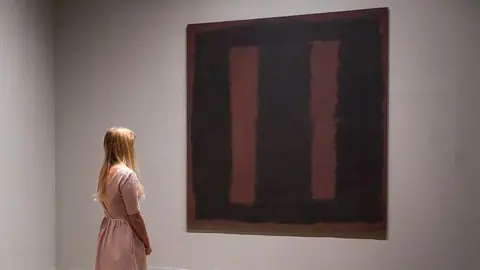
Rachel Myrtle, Head of Specie and Fine Arts at Aon, a company that offers insurance broking to its clients, said fine art insurance policies typically cover “all risks associated with physical loss and damage to artwork”.
This includes “accidental damage caused by children or visitors, albeit with certain exclusions”, she said.
She said that when an artwork is damaged, a gallery’s insurer will appoint a specialist fine art loss adjuster to visit the museum.
The loss adjustor typically “reviews the damage to the artwork, examines any CCTV footage to determine the exact cause of the loss, and assesses conservation options”, Ms Myrtle said.
The museum did not comment on who will be held liable for the damage to the 1960 painting, which the gallery reportedly bought in the 1970s.
The Museum Boijmans Van Beuningen has previously billed visitors who have caused damage to artworks on display.
In 2011, the museum asked an unsuspecting tourist who stepped on Wim T. Schippers’ peanut butter floor artwork, called Pindakaasvloer, to pay for repairs to the work. Sharon Cohen, a spokesperson for the museum at the time, wax quoted by AD as saying “It is normal procedure for people to pay if they damage art.”
The Rothko painting is described by the museum as an example of colour field painting, a term used to describe art characterised by large blocks of flat, solid colour spread across a canvas.
Rothko’s Grey, Orange on Maroon, No. 8 painting is one of several works of modern art that have been damaged in the Netherlands in recent years.
In November 2024, multiple screen prints by the US pop artist Andy Warhol were damaged by thieves during an attempted robbery of the MPV art gallery in the town of Oisterwijk.
In another incident, a Dutch town hall admitted it most likely disposed of 46 artworks by accident – including an Andy Warhol print of the former Dutch queen – during renovation works last year.
Museums have different policies when responding to damage caused by children.
In August last year, a four year old boy accidentally smashed a 3,500 year old jar into pieces at the Hecht Museum in Israel. At the time, Hecht Museum worker Lihi Laszlo told the BBC the museum would not treat the incident “with severity” because “the jar was accidentally damaged by a young child”.
The family were invited back to the exhibition for an organised tour shortly after the incident occurred.
[BBC]
Foreign News
‘Mass casualty incident’ as car driven into Vancouver street festival

Police are investigating a “mass casualty incident” in which “several people were killed” after a car was driven into a crowd in Vancouver.
Authorities in the Canadian city said “multiple others” were injured during the incident, which occurred at approximately 20:14 local time on Saturday (03:14 GMT on Sunday) at a street festival.
Police said a 30-year-old male suspect was in custody and that they were “confident that this incident was not an act of terrorism”. It is unclear how many people have been killed.
Police said the suspect had driven into pedestrians at the annual Lapu Lapu festival, which celebrates Filipino culture, at East 43rd Avenue and Fraser, in the south of Vancouver.
Steve Rai, Vancouver Police’s interim chief, told a news conference that there had been one vehicle and one suspect involved in the incident. He said more details would be released in the morning.
The owner of a food truck selling bao buns at the festival, Yoseb Vardeh, told the BBC World Service that the attack happened right in front of his van.
“This guy, he killed some of my customers,” he said. “There was people waiting for their buns that got hit.”
Mr Vardeh added: “I stepped outside of my food truck and I just saw bodies underneath people’s food trucks, husbands crying out for their wives or their kids… It was just horrible.”
Unverified footage posted on social media showed a number of police cars, ambulances and fire engines at the scene, with injured people lying on the ground.
Canadian Prime Minister Mark Carney said in a statement on X that he was “devastated to hear about the horrific events at the Lapu Lapu festival in Vancouver”.
He continued: “I offer my deepest condolences to the loved ones of those killed and injured, to the Filipino Canadian community, and to everyone in Vancouver. We are all mourning with you.”
He also thanked emergency responders for their “swift action”.
Vancouver Mayor Ken Sim said he was “shocked and deeply saddened by the horrific incident”, adding in a post that his “thoughts are with all those affected and with Vancouver’s Filipino community during this incredibly difficult time.”
One of Vancouver’s city councillors, Peter Fry, told the BBC that local residents were struggling to process what had happened.
“This celebration was a huge, fun, vibrant, family-orientated street party, and it was a fantastic event. To see it turn so horrible so quickly and unexpectedly has, I think, our entire city is in shock,” he said.
Lapu Lapu Day is celebrated every year in the Philippines on 27 April to commemorate Lapu-Lapu, a national hero who resisted Spanish colonisation.
The festival was officially set up in Vancouver in 2023. Its website says it “symbolises the cultural harmony and mutual respect that thrive in the province of British Columbia”.
In the wake of the attack, leaders of different political parties have also been sharing messages of condolence.
Pierre Poilievre, leader of Canada’s Conservative Party, called the incident a “senseless attack”, while the leader of the British Columbia New Democratic Party, David Eby, said he was “shocked and heartbroken”.
New Democratic Party leader Jagmeet Singh – who had attended the festival but was not present when the incident occurred – said he was “horrified to learn” that innocent people had been killed and injured.
“As we wait to learn more, our thoughts are with the victims and their families – and Vancouver’s Filipino community, who were coming together today to celebrate resilience,” he added.
Singh, Poilievre and Carney are all running in Canada’s federal election on Monday. Singh’s constituency of Burnaby Central lies just east of where the incident took place.
[BBC]
Foreign News
Trump questions Putin’s desire for peace after meeting Zelensky at the Vatican

Donald Trump has questioned Vladimir Putin’s willingness to end the war in Ukraine following his meeting with the country’s leader Volodymyr Zelensky on the sidelines of Pope Francis’s funeral.
Posting on social media after leaving Rome, Trump said he feared Putin was “tapping me along” after Moscow’s strikes on Kyiv earlier this week, adding there was “no reason for Putin to be shooting missiles into civilian areas”.
Earlier in the day Trump and Zelensky were seen in deep discussion in St Peter’s Basilica shortly before the funeral began.
The White House described the 15-minute meeting with Zelensky as “very productive”. The Ukrainian president said it had the “potential to become historic”.
It was Trump’s first face-to-face encounter with the Ukrainian president since February’s acrimonious Oval Office showdown.
Writing on his Truth Social account, Trump said the Russian attacks on Ukrainian cities “makes me think that maybe he doesn’t want to stop the war, he’s just tapping me along, and has to be dealt with differently, through ‘Banking’ or ‘Secondary Sanctions?'”.
Trump had previously said Russia and Ukraine were “very close to a deal” following three-hour talks between his envoy Steve Witkoff and the Russian president on Friday.
The Kremlin meanwhile said on Saturday that Putin had confirmed Russia’s readiness to enter into direct talks with Ukraine “without preconditions” to Witkoff.
During their last face-to-face meeting at the White House, Trump had told Zelensky “you don’t have the cards” and that he was not winning against Russia.
Trump repeated that message this week, saying the Ukrainian leader had “no cards to play”. He has previously blamed Ukraine for starting the war and has accused Zelensky multiple times of being an obstacle to peace negotiations.
But the White House struck a more positive tone about Saturday’s meeting, while Zelensky described the sit down as a “very symbolic” and one which could prove significant “if we achieve joint results”.
Two images were released of the meeting, showing the US leader in a blue suit and Ukrainian president in a black top and trousers, locked in intense conversation while sitting opposite each other.
Ukraine’s Foreign Minister Andrii Sybiha also posted an image of the meeting on X with the caption: “No words are needed to describe the importance of this historic meeting. Two leaders working for peace in St. Peter’s Basilica.”
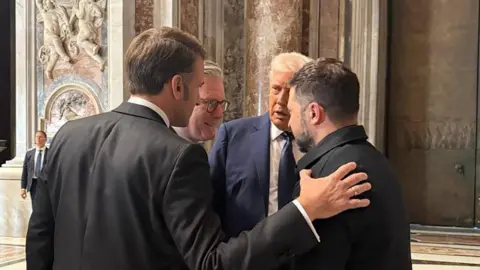
Another image posted by the Ukrainian delegation from inside St Peter’s showed the two men standing alongside UK Prime Minister Sir Keir Starmer and French President Emmanuel Macron, whose hand is on Zelensky’s shoulder.
The implication was that the two European leaders – who have regularly acted as intermediaries for Trump and Zelensky – had helped to bring the two together against the sombre backdrop of the funeral.
After the meeting, Trump and Zelensky walked down the steps of the basilica, where Zelensky’s arrival was met with applause from the crowds, and took their seats in the front row.
During the service, the pair sat a short distance from each other, with Macron and other heads of state in between.
In his homily, Cardinal Giovanni Battista Re spoke of Pope Francis’s incessant calls for peace. “‘Build bridges, not walls’ was an exhortation he repeated many times,” said the cardinal.
Ukrainian officials had talked of a possible second meeting, but Trump’s motorcade drove away from St Peter’s immediately afterwards and his plane left Rome a short time later.
Zelensky, however, later met Macron in the garden of Villa Bonaparte, home to the French embassy to the Holy See.
He also met Sir Keir at Villa Wolkonsky, the British ambassador’s residence, as well as holding separate talks with EU Commission President Ursula von der Leyen.
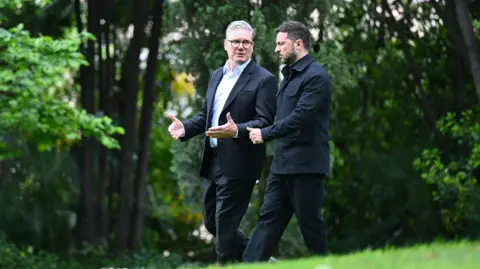
Macron said ending the war in Ukraine was an objective that “we share in common with President Trump” in a post on X, adding that Ukraine was ready for “an unconditional ceasefire”.
A Downing Street spokesperson said Starmer and Zelensky discussed the positive progress that had been made recently to “secure a just and lasting peace in Ukraine,” adding that the pair had agreed to “maintain momentum” and “speak again at the earliest opportunity”.
During February’s heated White House exchange, Trump accused the Ukraininan president of gambling with World War Three by not going along with ceasefire plans led by Washington.
Kyiv has been on the receiving end of growing pressure from Trump to accept territorial concessions as part of an agreement with Moscow to end the war.
These concessions would reportedly include giving up large portions of land, including the Crimean peninsula which was illegally annexed by Russia in 2014.
Zelensky has repeatedly rejected the idea in the past. He suggested to the BBC on Friday that “a full and unconditional ceasefire opens up the possibility to discuss everything”.
[BBC]
-

 Business3 days ago
Business3 days agoPick My Pet wins Best Pet Boarding and Grooming Facilitator award
-

 News3 days ago
News3 days agoNew Lankan HC to Australia assumes duties
-

 News1 day ago
News1 day agoJapan-funded anti-corruption project launched again
-

 News3 days ago
News3 days agoLankan ‘snow-white’ monkeys become a magnet for tourists
-

 Features3 days ago
Features3 days agoKing Donald and the executive presidency
-

 Business3 days ago
Business3 days agoACHE Honoured as best institute for American-standard education
-

 Features5 days ago
Features5 days agoThe Truth will set us free – I
-

 Business1 day ago
Business1 day agoNational Savings Bank appoints Ajith Akmeemana,Chief Financial Officer





